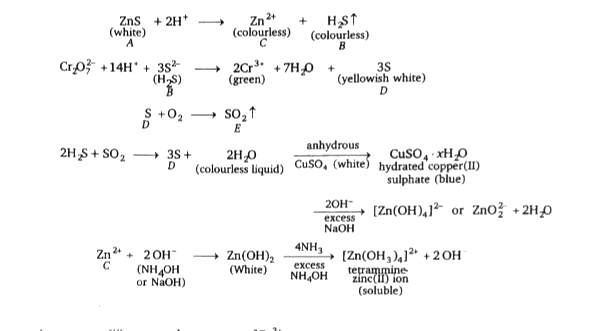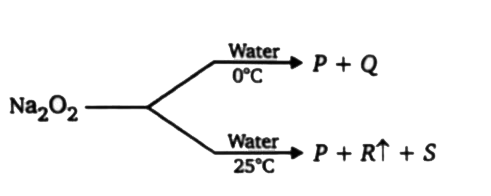A white solid A reacts with dilute H2SO4 to produce a colourless gas B and a colourless solution C. the reaction between B and acidified dichromate yields a green solution and a slightly coloured precipitate D. the substance D, when burnt in air, gives a gas E which reacts with B to yield D and a colourlesss liquid. anhydrous copper sulphate turns blue with this colourless liquid. the addition of aqueous NH3 or NaOH to C produces a precipitate that dissolves in an excess of the reagent to form a clear solution.
Q. Suppose the solution obtained by the treatment off the solution C with an excess of NaOH is acidified with acetic acid and the gas B is passed through it. which of the following will obtained?
A colourless solution
A yellow precipitate
A black precipitate
A white precipitate
The correct Answer is:D
One of the three colourless gases −CO2,SO2andH2S- is generally produced by the action of dilute H2SO4 on a salt. As the gas turns acidified dichromate solution green along with the formation of slightly coloured precipitate (may be S), the gas seems to be H2S and so the substance A seems to be a sulphide. again, the action of NH3 or an NaOH solution on the solution of the substance in dilute
H2SO4 suggets that the substance is a zinc salt. thus, A is most likely ZnS. let us go through the reactions now.

Topper's Solved these Questions
- QUALITATIVE INORGANIC ANALYSISBook:VK JAISWAL ENGLISHChapter:QUALITATIVE INORGANIC ANALYSISExercise:ONE OR MORE ANSWER IS/ARE CORRECT
Explore 43 Videos
- QUALITATIVE INORGANIC ANALYSISBook:VK JAISWAL ENGLISHChapter:QUALITATIVE INORGANIC ANALYSISExercise:MATCH THE COLUMN
Explore 4 Videos
- QUALITATIVE INORGANIC ANALYSISBook:VK JAISWAL ENGLISHChapter:QUALITATIVE INORGANIC ANALYSISExercise:LEVEL 2
Explore 76 Videos
- PERIODIC PROPERTIESBook:VK JAISWAL ENGLISHChapter:PERIODIC PROPERTIESExercise:MATCH THE COLUMN
Explore 11 Videos
- s-BLOCK ELEMENTSBook:VK JAISWAL ENGLISHChapter:s-BLOCK ELEMENTSExercise:SUBJECTIVE PROBLEMS
Explore 2 Videos
Similar Questions
Basic radical(s) which can not be identified by borax bead test:
View Solution
View SolutionWhen a reagent (X) reacts with Fe3+ salt solution turnsred due to the formation of a compound (Y). This reagent cause no change in colour with Fe2+ salt solution. Compound (X) and (Y) are respectively:
View Solution
View Solution
Calculate sum of bond order between same bonded atoms in Q and R compounds.
View SolutionIdentify A, B, C, D and E. A while substance A reacts with dilute H_2SO_4 to produce a colourless gas B and a colourless solution C. The reaction between B and acidified K_2Cr_2O_7 solution produces a green solution and slightly coloured precipitate D. The substance D burns in air to produce a gas E which reacts with B to yield D and a colourless liquid. Anhydrous copper sulphate is turned blue on adiition of this colourless liquid. Addition of aqueous NH_3 or NaOH to C produces first a precipitate
View SolutionA white substance A reacts with dilute H_(2)SO_(4) is produce a colourless B and acidified K_(2)Cr_(2)O_(7) solution produces a green solution and a slighly coloured precipitate D .The substance B to burns in air to produce a gas E which reacts with B ito yied D and a colouless liquid .Anhyhdrous copper sulphate is turned blue on addition of this colourless liquid addition od aqueous NH_(3) or NaOH to C produce first a precipitate which dissolve in the excess of the respective reagent to produce a clear solution in each case identify A,B,C, and E. Write the equation of the reaction involved.
View SolutionA white substance a reacts with dilute H2SO4 to produce a colourless gas B and a colourless solution C. The reaction between B and acidified K2Cr2O7 solution produces a green solution and a slightly coloured precipitate D. The substance D burns in air to produce a gas E which reacts with B to yield D and a colourless liquid. Anhydrous copper sulphate is turned blue on addition of this colourless liquid. Additio of aqueous NH3 or NaOH to C produces first a precipitate, produce a clear solution in each case. Identify A, B, C, D and E. Write the equations of the reactions involved.
View SolutionA white substance (A) reacts with dilute H2SO4 to produce a colourless gas (B) and a colourless solution (C). The reaction between (B) and acidified K2Cr2O7 solution produces a green solution and a slightly coloured precipitate (D). Addition of aqueous ammonia or sodium hydroxide to (C) produces first a precipitate, which dissolves in the excess of teh respective reagent to produce a clear solution in each case.
The colourless gas (B) is:
View SolutionA white substance (A) reacts with dilute H_(2)SO_(4) to produce a colourless gas (B) and a colourless solution ( C) .The reaction between (B) and acidified K_(2)Cr_(2)O_(7) solution produces a green solution and a slightly coloured precipitate (D) .The substance (D) burns in air to produce a gas (E) which reacts with (B) to yield (D) and a colourless liquid. Anhydrous copper sulphate is turned blue on addition of this colouless liquid.Addition of aqueous NH_(3) or NaOH to ( C) produces first a white precipitate which dissolves in the excess of the respective reagent to produce a clear solution in each case. Identify (A),(B),( C),(D) and (E) .
View SolutionA coloured compound (A) reacts with dilute H_(2)SO_(4) to produce a colourless gas (B) and colourless solution (C). The reaction between (B) and the acidified K_(2)Cr_(2)O_(7) solution produces a green solution and a slightly yellowise precipitate (D). the substance (D) burns in air to produce a gas (E) which also can change the colour of K_(2)Cr_(2)O_(7) solution. Q. When "B" reacts with "E"
View SolutionA coloured compound (A) reacts with dilute H_(2)SO_(4) to produce a colourless gas (B) and colourless solution (C). The reaction between (B) and the acidified K_(2)Cr_(2)O_(7) solution produces a green solution and a slightly yellowise precipitate (D). the substance (D) burns in air to produce a gas (E) which also can change the colour of K_(2)Cr_(2)O_(7) solution. Q. Which is not correct about E
View SolutionA coloured compound (A) reacts with dilute H_(2)SO_(4) to produce a colourless gas (B) and colourless solution (C). The reaction between (B) and the acidified K_(2)Cr_(2)O_(7) solution produces a green solution and a slightly yellowish precipitate (D). the substance (D) burns in air to produce a gas (E) which also cann change the colour of K_(2)Cr_(2)O_(7) solution. Q. When "B" racts with "E":
View SolutionA coloured compound (A) reacts with dilute H2SO4 to produce a colourless gas (B) and colourless solution (C). The reaction between (B) and the acidified K2Cr2O7 solution produces a green solution and a slightly yellowish precipitate (D). the substance (D) burns in air to produce a gas (E) which also cann change the colour of K2Cr2O7 solution.
Q. Which is not correct about E ?
View SolutionA white solid A reacts with dilute H_(2)SO_(4) to produce a colourless gas B and a colourless solution C. the reaction between B and acidified dichromate yields a green solution and a slightly coloured precipitate D. the substance D, when burnt in air, gives a gas E which reacts with B to yield D and a colourlesss liquid. anhydrous copper sulphate turns blue with this colourless liquid. the addition of aqueous NH_(3) or NaOH to C produces a precipitate that dissolves in an excess of the reagent to form a clear solution. Q. Which of the following gases are B and E respectively?
View SolutionA white solid A reacts with dilute H_(2)SO_(4) to produce a colourless gas B and a colourless solution C. the reaction between B and acidified dichromate yields a green solution and a slightly coloured precipitate D. the substance D, when burnt in air, gives a gas E which reacts with B to yield D and a colourlesss liquid. anhydrous copper sulphate turns blue with this colourless liquid. the addition of aqueous NH_(3) or NaOH to C produces a precipitate that dissolves in an excess of the reagent to form a clear solution. Q. What would happen if the gas E were passed through an acidified KMnO_(4) solution?
View Solution
